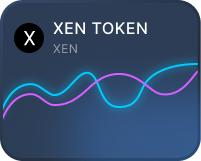XEN is a breeze of fresh air in the crypto space. The coin value put on your time preference and on the number of like minded people. You can get the token for free just for being you.

XEN Crypto is a collaborative project of people building for the XEN community.
It is an effort made by the crypto community to educate others about the freedom to create and channel economic energy through the XEN token. We want to spread information about the first principles delineated by Satoshi Nakamoto in the Bitcoin Whitepaper and brought back by Jack Levin, the founder of XEN. Our effort is directed at promoting self-custody, trust through consensus, transparency, and decentralization. All of these principles are reflected in XEN.
XEN Crypto is a small part of a larger community. It organized itself, realizing that the value of the XEN token came from itself. Nothing is more important than a single person minting XEN and expressing a desire to give value to it.

Self-custody is the first principle of the blockchain, and XEN Crypto makes it a priority because you can mint XEN only when you’re in control of your keys.

The XEN Crypto smart contract is open source and records of every claim rank and XEN mint are visible on-chain, eliminating any bias from the equation.

XEN achieves a wide degree of decentralization through high supply distribution, reliance on blockchain technology, and presence on multiple chains.
XEN is an ERC-20 token built on the Ethereum blockchain. It exists on 10 chains. It’s based on the first principles of crypto like decentralization, self-custody, transparency, and trust through consensus. The XEN smart contract is immutable, it has no admin keys, and it’s open source.
XEN has no fixed supply, and XEN tokens will be created in perpetuity. However, XEN has no initial supply either. It starts from zero, and every user mints their own XEN and can do this forever. The algorithm will automatically adjust the minting difficulty depending on the rank a user has and the number of people that joined the network after him. The XEN supply is inflationary at the beginning and disinflationary in the long run. It may turn deflationary when more XEN is burned than created.
XEN is minted into existence by the users and is put on sale on different decentralized exchanges. XEN is also available on centralized exchanges. We provided a comprehensive guide on where to swap and trade your XEN on various chains.
XEN tokens can be minted by anyone for free. The only thing you need is an Ethereum wallet like Metamask, for example, and some ETH to pay for the gas fee. First, you need to connect your wallet to the XEN dapp, indicate the number of days you want to spend on minting your XEN, and claim your cRank. You need to sign the transaction and pay the gas fee. Then you need to wait for the end of your term, and when this happens, you need to connect the wallet again, and mint XEN by signing the transaction and paying the gas fee.
The XEN founder is Jack Levin, who was part of the early Google team. He’s a serial entrepreneur who created ImageShack, Nventify, and the Fair Crypto Foundation, behind XEN Crypto. He was an early Bitcoin miner, and he’s also a biohacker.
The XEN Crypto smart contract was launched on Ethereum on October 8, 2022. It was deployed on the other 9 chains within two months. It lives on Polygon, BSC, Avalanche, Ethereum PoW, Moonbeam, Evmos, Fantom, Dogechain, and OKX Chain. The official XEN dApp website where you need to connect to claim your rank is xen.network.
XEN was inspired by bitcoin, but there are some significant differences. Bitcoin has a finite supply of 21 million BTC, while XEN has no finite supply. The Bitcoin and XEN supply started from zero, and the coins are created by miners. It’s an inflationary process; however, it will end in Bitcoin when it reaches 21 million, while in XEN it will continue going on. Bitcoin is also deflationary because of the halving that happens every four years, and when the maximum number of coins gets created, every lost coin will contribute to the deflationary effect. XEN is disinflationary because of an ongoing, decreasing amplifier that reduces the emission of coins. XEN’s burning mechanism may turn it into a deflationary token. Bitcoin is mined using computer power, while XEN is minted by users by connecting their wallets to a dapp. Bitcoin has its own blockchain, and XEN is a smart contract running on Ethereum and other 9 chains.
XEN resembles HEX because it values long-term preference. Both projects reward the holders for the amount of time they invest in holding on to their tokens. The yield that is paid to stakers comes from inflation and not other users. They are inflationary because their supply grows, but, at the same time, HEX has a decreasing number of T-shares, determining how the daily inflation gets split up between the stakers, while XEN’s emission decreases over time and depends on the delta rank of each user. HEX has an original address that holds the majority of tokens, whereas XEN does not have an OA and each user can mint XEN on their own. HEX tokens were made based on the donations they got from users, while XEN starts with no supply and gets new ones through a process called “free minting,” which everyone does.
Every user can create as many accounts as he wants. There’s no limit. The only limitation is that once you’ve claimed your rank and are waiting for your tokens to be minted, you can’t claim another cRank with the same account. You need to wait until the end of your term to be able to restart the process again. To mint multiple times in one go you can use XENFTs.
You can claim your cRank once and wait for the mint term to end. Once you have minted your XEN, you can restart the process again. Everything depends on the length of your mint term. You can mint as many times as you want when you use the XENFTs.















